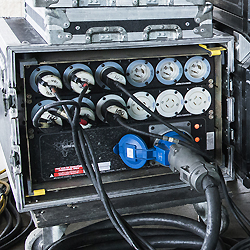
The branch circuits may include Edison outlets, Twist Lock outlets (popular for equipment that needs more than one Hot conductor) or even multi conductor 6-circuit 19-pin connectors (a.k.a., SOCAPEX, SOCA, or VEAM) that can be used with a multi cable and provide multiple circuits to one location.
SOCA cables are commonly used to provide six circuits of AC to self-powered line arrays. A fan-out converts the multi-pin into individual circuits or power.
A common temporary portable power distribution center often deployed with generators at outdoor events is called a Spider Box. These small units distribute a single phase input (two Hot supply circuits) into branch circuits protected by breakers. Many of these units have a supply output connector so they can be daisy chained.
Wrapping It Up
Speaking of generators, never use general construction types for production equipment. We require generators that run at a constant voltage and stable frequency while producing as little noise as possible. These type of units are known as “production,” “show,” “entertainment,” “quiet,” or “whisper” generators, and have excellent voltage regulation, usually within 1.5-percent tolerances or better.
Standard construction type generators are usually not as reliable as show types, and are often quite unstable. (By as much as 25 percent.) This may be O.K. for running power tools on construction sites, but not very good for sensitive electronics like audio equipment.
There are several things to keep in mind when working with a generator. Place it in an area that’s not accessible to the general public. Park it on a flat, level site that allows easy access for refueling. Chock the wheels to prevent unwanted rolling. Check oil, fuel and water levels before use, and monitor these levels throughout the day.
Also check and set all voltage and phase switches to the proper settings for your needs. Place all load breakers in the “off” position before starting or stopping the unit. Always install a ground rod or tie the unit into an existing approved ground as per the local code.
Make sure the generator is not running when connecting cables to the lugs. When connecting the service cables, connect the Ground wire first, then the Neutral, then the Hot. Meter the outputs before connecting equipment to ensure the unit is operating properly.
Finally, check all power distribution system components before use, and perform preventive maintenance on cables, connectors and components a few times a year. Look for bent or broken off connector pins or blades (Ground pins are commonly broken off in the field to provide a quick but dangerous fix for buzz in PA systems), damaged or exposed wiring, and non-functioning parts like indicator lights or breakers.
If an item is damaged at a show, pull it from service until it can be correctly repaired. Treat electricity with the respect it deserves and the gig will go much more smoothly – and no one gets hurt.
Senior contributing editor Craig Leerman is the owner of Tech Works, a production company based in Las Vegas.


